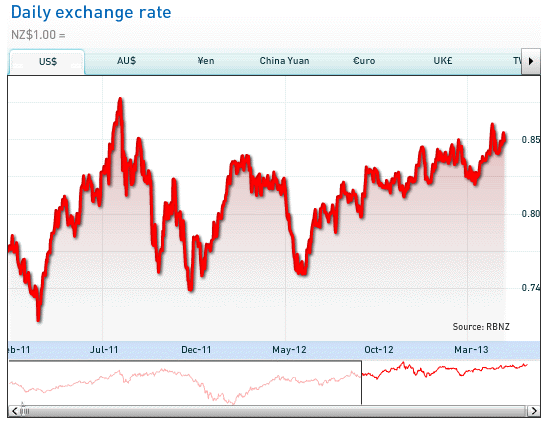By Gareth Vaughan
Here's our monthly currencies outlook and review with HiFX's senior dealer Dan Bell including a look at the latest statement from the US Federal Reserve's Federal Open Market Committee (FOMC).
Overnight (NZ time) the FOMC surprised no one by leaving benchmark interest rates unchanged at 0% to 0.25% and continuing the quantitative easing (QE), or money printing, programme whereby the Fed's buying US$85 billion worth of bonds per month.
"So steady as she goes on the printing press in the US," says Bell. "Based on today's statement it doesn't look like they're going to be putting away the printing press anytime soon."
Bell suggests "fiscal drag" is having an impact on the US economy now given that earlier in the year, and in the last quarter of 2012, US economic data had been improving.
"There's a fiscal drag going on. Government spending has been reined in over the last few months and I think that's having an impact. And we know that the sequestration and the other fiscal issues earlier in the year, and towards the end of last year, are really starting to show up in some of the numbers that we're seeing at the moment. So the (economic) data out of the States hasn't been that flash."
And with inflation still very low at around 1.5%, Bell says the Fed's set to maintain its current policy stance.
"But there are still some of the voting members in the Fed concerned about what they're doing. By early 2014 the Fed would've expanded its balance sheet by US$4 trillion through this money printing and that's a lot to deal with," says Bell. "At some stage they're going to hope to try and exit this position and that's going to be difficult."
"If we did see a real pick up in the US economy in the second-half of this year then I do believe you will see the market start to price in a tapering off in this stimulus approach. And ultimately when they do start to talk about tapering off this QE it should be positive for the US dollar and generally negative for the NZ dollar," says Bell.
What's up with gold?
Meanwhile, Bell says the recent fall in the gold price has been followed closely. Based on the London end-of-day fixings, as charted by interest.co.nz (see chart below), the gold price peaked at US$1,895 per Troy ounce in early September 2011. Overnight (NZ time) it closed at US$1454.75, down a whopping NZ$440.25, or 23%.
Gold is generally viewed by investors as a hedge against inflation and is seen as a safe haven asset against risk and recession. Bell says the recent fall is mostly to do with the fact the inflation some investors had been expecting to materialise through central banks' money printing hasn't materialised so far.
"So everyone was thinking if all these global central banks, and you look at the Bank of Japan, the Bank of England, the European Central Bank, and the US Fed, all the biggest central banks in the world are out there printing money, surely that's going to create inflation."
"But the fact is that it hasn't, and in fact there is some concern about dis-inflation in certain economies at the moment. So we just don't have inflation. And I think the big drop that we've seen in gold prices is essentially some investors recalibrating their outlook towards using gold as an inflation hedge," Bell says.
Precious metals
Select chart tabs
Will the RBA cut rates?
The Reserve Bank of Australia (RBA) is due to review its cash rate next Tuesday, which is currently at 3%. Bell says the market is expecting no change. However, one view is that it's a 50-50 call on the basis there's little inflation, and if the RBA can cut interest rates at the moment why wouldn't they, especially given, at 3%, Australia has one of the highest cash rates in the developed world.
"So they've still got room to move and if they want to try and rebalance their economy, then they'd like to see the Australian dollar trend lower which would give some relief to their manufacturing exporters," Bell says.
"The Australian story is interesting. They had a manufacturing number out this week which was the worst since 2009. Their terms of trade have peaked. We know that the investment into resources and mining has peaked and it's starting to really taper off. And export commodity prices in Australia's major markets are starting to drift lower."
"Copper prices are at 18 month lows, iron ore prices are weaker and the recent run of data out of China (Australia's key export market) has been worse than expected," Bell adds.
To subscribe to our free daily Currency Rate Sheet and News email, enter your email address here.
----------------------------------------------------------------------------
Dan Bell is the Senior Dealer at HiFX, a UK-headquartered foreign exchange dealer with significant operations in Australia and New Zealand. It has a dealing room in Auckland. See more detail here.






We welcome your comments below. If you are not already registered, please register to comment.
Remember we welcome robust, respectful and insightful debate. We don't welcome abusive or defamatory comments and will de-register those repeatedly making such comments. Our current comment policy is here.